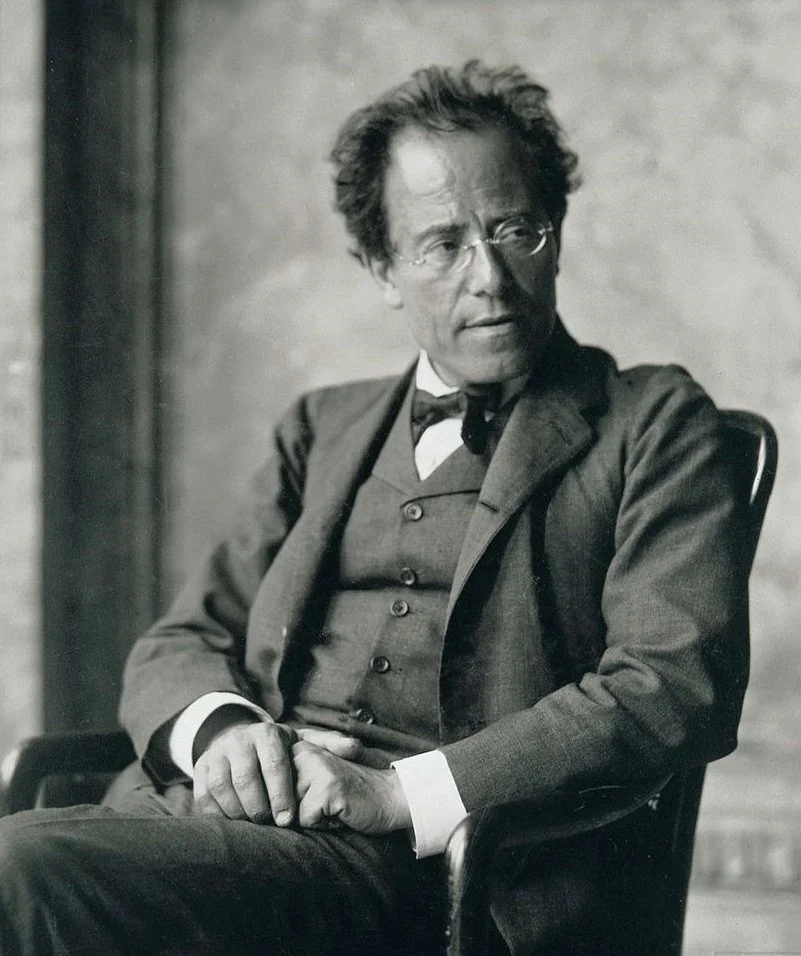Behind the Music
Mahler 3
Mahler 3
Experience one of the greatest symphonies ever written - Mahler’s 3rd Symphony
All of nature and human existence in Mahler’s most ambitious symphony
January 20 · 8pm · Warner Theatre
Featuring one of the largest orchestras you’ll ever see along with the Women from the Erie Philharmonic Chorus, the Junior Chorus and Youth Chorale plus mezzo-soprano Lindsay Ammann, this is truly a once-in-a-lifetime concert experience. And you get to see it right here in Erie!
Keep scrolling for a look behind the score from this massive work.
Getting Started
Music Director Daniel Meyer’s Top 10 reasons to be excited for Mahler 3
Listen to this massive work!
A Captivating Spectacle
The beginning…
…and the end.
(Jump ahead to 21:00 for the really loud part!!)
Gustav Mahler
“Just imagine a work of such magnitude that it actually mirrors the whole world—one is, so to speak, only an instrument, played on by the universe…My symphony will be something the like of which the world has never yet heard!…In it the whole of nature finds a voice.”
The sounds of bells
Transitioning from the reflective fourth movement, the fifth part of Mahler's Third Symphony introduces a blissful chorus, merging the Erie Junior Philharmonic Chorus, Youth Chorale, and the Women from the Erie Philharmonic Chorus. This movement, inspired by Mahler's "Wunderhorn" song "Es sungen drei Engel," brings a narrative of redemption and grace, with angelic voices singing of hope and salvation. The music, symbolizing a journey from contemplation to spiritual upliftment, concludes with a resonant "Ding, dong, ding, dong…", reflecting both the hymn's end and the transcendence it embodies. This ethereal segment promises an enriching and soul-stirring experience for the audience.
A sound from another world
A captivating moment occurs in the trio section of the 3rd movement scherzo (around 5:40 on this recoding). An offstage "post horn" solo, played on a flugelhorn, distinctively interrupts the symphony. This instrument, echoing the sound of a historical post horn and blending the softness of a French horn with the clarity of a trumpet, joins two French horns to create a deeply emotional and nostalgic melody. This passage, unique and mesmerizing, invites listeners to pause and immerse in its spellbinding sound. Click below for even more info:
A Deeper Dive
Enjoy two captivating videos further examining the epic magnitude of Mahler’s Third Symphony.
The Midnight Song
In the fourth movement of Mahler's Symphony No. 3, the exceptional alto Lindsay Ammann brings her extensive operatic experience to the forefront.
Celebrated for her rich and emotive voice, Lindsay has captivated audiences worldwide, from the Metropolitan Opera to the Bayerische Staatsoper. Her deep understanding of musical narrative and emotion makes her an ideal interpreter of this pivotal movement in Mahler's symphony. Lindsay's ability to convey the profound emotional landscape of Mahler's composition promises to make her performance a standout feature in this epic work, highlighting the heart and soul of this symphonic masterpiece.
Enjoy a bonus collection of curated videos delving into the magnificence that is Mahler’s Third Symphony.
Video Corner
Listening Guide
A fabulous listening guide for Mahler’s epic Third Symphony created by the Mahler Foundation itself.
“Mahler’s gigantic third Symphony is his paean to pantheism, his great hymn to nature. According to the model’s program, its six movements are arranged in a progressive sequence from inanimate nature to the creator of the universe who Mahler equates with love.”
Click below to read more.
The Story
Mahler’s epic third symphony is divided into six movements, made up of two parts.
Click below to learn more.
Part One
-
The opening movement of Mahler's symphony is a powerful ode to the vibrancy of life, evoking the imagery of spring's awakening and summer's triumphant arrival as described by Mahler. It starts with a forceful horn theme, reminiscent yet distinct from the noble theme in Brahms’ First Symphony's final movement, shifting from Brahms' harmonious chorale to a more raw and foreboding sound. Mahler seems to challenge the listener, suggesting complexity and depth beyond simplicity.
Throughout this movement, Mahler's metaphysical vision comes to life. Sounds range from the soft rumble of the bass drum to ethereal harmonies formed by novel instrumental combinations, expressing triumph, sorrow, exhilaration, and fear. The music's scope includes the haunting solo trombone and pastoral woodwind melodies, culminating in a march that evolves from quiet intensity to overwhelming power, encapsulating everything from the sinister to the innocent.
The orchestration in this movement seems to continue the narrative style Berlioz pioneered in "Symphonie fantastique." Notice, for instance, how a two-note descending string motif persistently interrupts, leading to a dramatic and multifaceted transition, or the unexpected appearance of the "William Tell" trumpet call towards the end. Rather than deciphering their precise meanings, it's perhaps more rewarding to simply immerse in and listen to what these musical voices convey.
Part Two
-
Transitioning from the first movement's exuberant spirit, the symphony enters a pastoral scene with a Tempo di menuetto. This section embodies a sense of simple, unadorned beauty and sensuality, reminiscent of blooming flowers. Mahler himself described it as his most lighthearted composition, akin to the effortless grace of flowers swaying in the breeze. Notice how the opening melody reappears throughout, each time adorned with increasingly rich embellishments, capturing the essence of nature's effortless elegance.
-
In its third movement, the symphony ascends to the realm of forest animals and birds, drawing inspiration from Mahler's song "Ablösung im Sommer" ("The Changing Guard of Summer") from "Des Knaben Wunderhorn." The narrative reflects on the changing of seasons, as the cuckoo's demise at spring's end leads to the nightingale's elaborate and joyful song, filling the silence left by other birds.
This movement features a notable shift in the second trio section, where the vibrant forest sounds give way to the calm, distant call of an off-stage post-horn. This serene moment includes an unexpected nod to the Spanish folk tune "Jota aragonesa," recognizable from Liszt’s "Rhapsodie espagnole." However, this tranquility is abruptly disrupted by a military trumpet fanfare. The movement concludes with a powerful resurgence of the animal kingdom's vitality, marked by a burst of unbridled energy.
-
The fourth movement of the symphony ushers us into an enigmatic realm, where time seems to stand still, reminiscent of 20th-century minimalism as seen in works of composers like Henryk Gorecki. This movement begins with a solemn, oscillating whole-step motif, echoing the first movement's opening, but now emerging from silence. For the first time in the Symphony, the human voice is introduced, not with the bright timbre of a soprano but through the deeper, more resonant tones of an alto. The lyrics are drawn from the "Midnight Song" in Friedrich Nietzsche's "Also sprach Zarathustra." The text poetically delves into themes of deep contemplation, contrasting the profundity of joy and suffering, and the eternal nature of joy in the face of transient woes. This passage evokes a profound reflection on the depth and complexity of human experience.
-
Following the contemplative fourth movement, the symphony transitions as the somber reflection on humanity's tragedy and self-awareness fades, giving way to a burst of joyful sounds. This shift introduces a heavenly chorus, reminiscent of angelic laughter and the pealing of celestial bells. In its final moments, a trombone descant subtly nods to the instrument's historical role in church music, particularly in vocal accompaniment.
This joyous segment is inspired by Mahler's "Wunderhorn" song "Es sungen drei Engel," based on a 17th-century hymn. The lyrics convey a narrative of redemption and divine grace, painting a scene where angels sing of St. Peter's absolution and of hope for all through Jesus. It speaks of breaking and repenting for sins, praying to God, and the promise of heavenly joy and salvation. The movement concludes with the echoing "Ding, dong, ding, dong…", symbolizing both the conclusion of the hymn and the transcendence it represents.
-
As the ethereal bell tones from the previous movement fade, the symphony embarks on its final, transformative journey. The initial chords of this movement render all that preceded seemingly insignificant. This passage, referred to by Mahler as akin to "What God tells me," embodies the essence of divine love, marking the culmination of a journey from inanimate nature to divine affection.
The expansive first theme of this movement is introduced by a dominant-tonic resolution, symbolizing a harmonic return to 'home.' Each repetition of this cadence unveils new dimensions and insights. It starts as a hushed, reverent murmur in the strings, evolves into a high woodwind melody blending innocence with sorrow, and ultimately transforms into a powerful, heroic horn theme.
Reflecting the dualistic nature prevalent in Mahler's work, this movement juxtaposes contrasting emotions and images, like a street organ encountering a funeral procession. The horns' unison statement leads into the symphony's most uplifting music, which abruptly shifts into the harsh tones of stopped horns, revealing an undercurrent of darkness. A solitary flute and a static horn note, reminiscent of Bruckner's symphonies, lead us back to the pivotal V-I resolution, setting the stage for the symphony's final, transformative climax. The upper strings lift the orchestra, and just before the grand conclusion, a moment of quiet mystery offers a fleeting glimpse, allowing the music to release and conclude this monumental journey.



